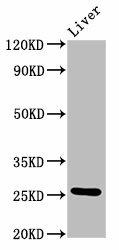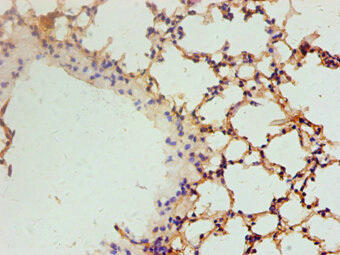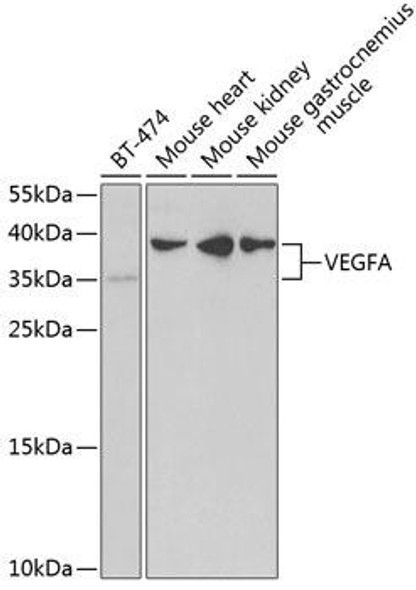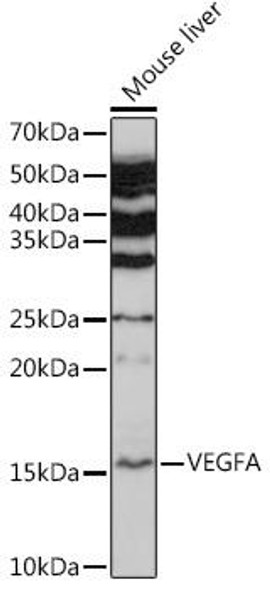Description
| Antibody Name: | Vegfa Antibody (PACO32564) |
| Antibody SKU: | PACO32564 |
| Size: | 50ug |
| Host Species: | Rabbit |
| Tested Applications: | ELISA, WB, IHC |
| Recommended Dilutions: | ELISA:1:2000-1:10000, WB:1:500-1:5000, IHC:1:50-1:500 |
| Species Reactivity: | Rat |
| Immunogen: | Recombinant Rat Vascular endothelial growth factor A protein (27-232AA) |
| Form: | Liquid |
| Storage Buffer: | Preservative: 0.03% Proclin 300 Constituents: 50% Glycerol, 0.01M PBS, PH 7.4 |
| Purification Method: | >95%, Protein G purified |
| Clonality: | Polyclonal |
| Isotype: | IgG |
| Conjugate: | Non-conjugated |
 | Western Blot Positive WB detected in: Rat liver tissue All lanes: Vegfa antibody at 4.8µg/ml Secondary Goat polyclonal to rabbit IgG at 1/50000 dilution Predicted band size: 26, 23, 21, 18 kDa Observed band size: 26 kDa . |
 | Immunohistochemistry of paraffin-embedded mouse lung tissue using PACO32564 at dilution of 1:100. |
| Background: | Growth factor active in angiogenesis, vasculogenesis and endothelial cell growth. Induces endothelial cell proliferation, promotes cell migration, inhibits apoptosis and induces permeabilization of blood vessels. Binds to the FLT1/VEGFR1 and KDR/VEGFR2 receptors, heparan sulfate and heparin. May play a role in increasing vascular permeability during lactation, when increased transport of molecules from the blood is required for efficient milk protein synthesis. |
| Synonyms: | Vascular endothelial growth factor A (VEGF-A) (Vascular permeability factor) (VPF), Vegfa, Vegf |
| UniProt Protein Function: | VEGF: Growth factor active in angiogenesis, vasculogenesis and endothelial cell growth. Induces endothelial cell proliferation, promotes cell migration, inhibits apoptosis and induces permeabilization of blood vessels. Binds to the FLT1/VEGFR1 and KDR/VEGFR2 receptors, heparan sulfate and heparin. NRP1/Neuropilin-1 binds isoforms VEGF-165 and VEGF-145. Isoform VEGF165B binds to KDR but does not activate downstream signaling pathways, does not activate angiogenesis and inhibits tumor growth. Defects in VEGFA are a cause of susceptibility to microvascular complications of diabetes type 1 (MVCD1). These are pathological conditions that develop in numerous tissues and organs as a consequence of diabetes mellitus. They include diabetic retinopathy, diabetic nephropathy leading to end-stage renal disease, and diabetic neuropathy. Diabetic retinopathy remains the major cause of new-onset blindness among diabetic adults. It is characterized by vascular permeability and increased tissue ischemia and angiogenesis. Belongs to the PDGF/VEGF growth factor family. 13 isoforms of the human protein are produced by alternative promoter. |
| UniProt Protein Details: | Protein type:Cytokine; Secreted, signal peptide; Motility/polarity/chemotaxis; Secreted Cellular Component: basement membrane; cell surface; cytoplasm; extracellular region; extracellular space; membrane; nucleus; secretory granule Molecular Function:chemoattractant activity; cytokine activity; extracellular matrix binding; fibronectin binding; growth factor activity; growth factor binding; heparin binding; identical protein binding; platelet-derived growth factor receptor binding; protein heterodimerization activity; protein homodimerization activity; receptor agonist activity; receptor binding; vascular endothelial growth factor receptor 1 binding; vascular endothelial growth factor receptor 2 binding; vascular endothelial growth factor receptor binding Biological Process: activation of CREB transcription factor; activation of protein kinase activity; aging; alveolus development; angiogenesis; artery morphogenesis; basophil chemotaxis; blood vessel development; blood vessel endothelial cell proliferation during sprouting angiogenesis; blood vessel morphogenesis; blood vessel remodeling; branching morphogenesis of a tube; camera-type eye morphogenesis; cardiac muscle fiber development; cell differentiation; cell maturation; cell migration; cell migration during sprouting angiogenesis; cell proliferation; endothelial cell migration; epithelial cell differentiation; eye photoreceptor cell development; female pregnancy; growth; heart morphogenesis; homeostasis of number of cells within a tissue; hyaluronan metabolic process; in utero embryonic development; induction of positive chemotaxis; kidney development; lactation; lumen formation; lung development; lymphangiogenesis; macrophage differentiation; mesoderm development; monocyte differentiation; mRNA stabilization; negative regulation of apoptosis; negative regulation of bone resorption; negative regulation of caspase activity; negative regulation of cell-cell adhesion; negative regulation of fat cell differentiation; negative regulation of neuron apoptosis; negative regulation of programmed cell death; negative regulation of transcription from RNA polymerase II promoter; nervous system development; neuron development; ovarian follicle development; patterning of blood vessels; positive chemotaxis; positive regulation of angiogenesis; positive regulation of axon extension involved in axon guidance; positive regulation of blood vessel endothelial cell migration; positive regulation of cell adhesion; positive regulation of cell division; positive regulation of cell migration; positive regulation of cell motility; positive regulation of cell proliferation; positive regulation of endothelial cell proliferation; positive regulation of epithelial cell proliferation; positive regulation of focal adhesion formation; positive regulation of MAP kinase activity; positive regulation of mesenchymal cell proliferation; positive regulation of neuroblast proliferation; positive regulation of osteoblast differentiation; positive regulation of peptidyl-serine phosphorylation; positive regulation of peptidyl-tyrosine phosphorylation; positive regulation of positive chemotaxis; positive regulation of protein amino acid autophosphorylation; positive regulation of protein amino acid phosphorylation; positive regulation of protein complex assembly; positive regulation of protein kinase B signaling cascade; positive regulation of receptor internalization; positive regulation of signal transduction; positive regulation of smooth muscle cell proliferation; positive regulation of transcription from RNA polymerase II promoter; positive regulation of vascular endothelial growth factor receptor signaling pathway; positive regulation of vascular permeability; post-embryonic camera-type eye development; regulation of cell shape; regulation of cGMP metabolic process; regulation of endothelial cell differentiation; regulation of transcription from RNA polymerase II promoter; response to cold; response to estradiol stimulus; response to folic acid; response to hypoxia; response to progesterone stimulus; response to vitamin A; sprouting angiogenesis; surfactant homeostasis; T-helper 1 type immune response; vascular endothelial growth factor receptor signaling pathway; vasculature development; wound healing |
| NCBI Summary: | This gene is a member of the PDGF/VEGF growth factor family. It encodes a heparin-binding protein, which exists as a disulfide-linked homodimer. This growth factor induces proliferation and migration of vascular endothelial cells, and is essential for both physiological and pathological angiogenesis. Disruption of this gene in mice resulted in abnormal embryonic blood vessel formation. This gene is upregulated in many known tumors and its expression is correlated with tumor stage and progression. Alternatively spliced transcript variants encoding different isoforms have been found for this gene. There is also evidence for alternative translation initiation from upstream non-AUG (CUG) codons resulting in additional isoforms. A recent study showed that a C-terminally extended isoform is produced by use of an alternative in-frame translation termination codon via a stop codon readthrough mechanism, and that this isoform is antiangiogenic. Expression of some isoforms derived from the AUG start codon is regulated by a small upstream open reading frame, which is located within an internal ribosome entry site. [provided by RefSeq, Nov 2015] |
| UniProt Code: | P16612 |
| NCBI GenInfo Identifier: | 17380502 |
| NCBI Gene ID: | 83785 |
| NCBI Accession: | P16612.2 |
| UniProt Secondary Accession: | P16612,Q541S6, Q91ZE1, Q9JKX7, Q9QXG6, Q9QXG7, |
| UniProt Related Accession: | P16612 |
| Molecular Weight: | 17,189 Da |
| NCBI Full Name: | Vascular endothelial growth factor A |
| NCBI Synonym Full Names: | vascular endothelial growth factor A |
| NCBI Official Symbol: | Vegfa |
| NCBI Official Synonym Symbols: | VPF; Vegf; VEGF-A; VEGF164 |
| NCBI Protein Information: | vascular endothelial growth factor A |
| UniProt Protein Name: | Vascular endothelial growth factor A |
| UniProt Synonym Protein Names: | Vascular permeability factor; VPF |
| Protein Family: | VEGF coregulated chemokine |
| UniProt Gene Name: | Vegfa |
| UniProt Entry Name: | VEGFA_RAT |






